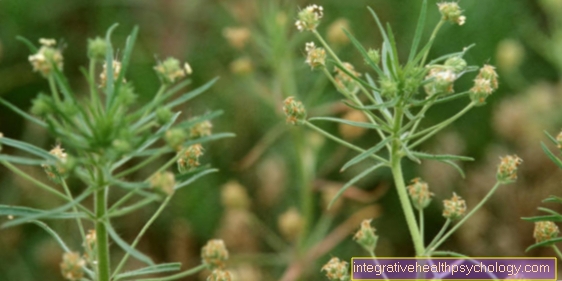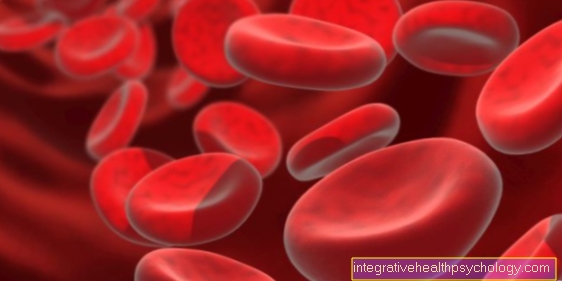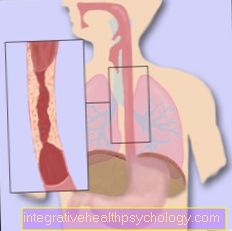Cross allergy
definition
A cross allergy is a type of allergic reaction. In an allergic reaction, certain antibodies react (IgE antibodies) to an allergen (for example pollen) and a allergic reaction, for example in the form of skin rash or Irritation of the mucous membranes With itchy eyes and increased sneezing. In the case of a cross allergy, the antibody does not only dissolve on contact with the Origin allergen (for example pollen) but also in contact with certain other allergens (for example kiwi fruit) an allergic reaction. It is very different from person to person whether and to what extent there is a cross allergy and which other allergens it includes.

causes
If the human body is confronted with an allergen, it can increased sensitivity (sensitivity) come to the fact that he forms antibodies to this allergen. It then comes at every new exposure with the allergen causing an allergic reaction. The antibodies recognize special patterns on the surface of the allergen. If they bind or couple to them, this will trigger a Immune reaction which leads to the allergic reaction. The antibody recognizes the pollen on the surface of which it can dock, thus triggers an immunological reaction and the person concerned notices this when, for example, he is red, itchy eyes Has. In the case of a cross allergy, the antibody also binds to patterns on the surface of allergens. However, they are not exactly the same as those of the original allergen but are very similar to them. This then leads to the fact that substances that originally did not actually trigger an allergic reaction now do so.
Allergens and possible cross allergens
| ALLERGENS | POSSIBLE CROSS ALLERGENS |
birch
|
Other pollen: beech, alder, oak, ash, hazel Food: Nuts, carrots, tomatoes, soy, many types of pome and stone fruit, strawberry, parsley, pepper |
Grain pollen
|
Other pollen: ryegrass, cereals (such as wheat, spelled, barley, oats, millet, corn, rice) Food: cereal flour |
Grasses
|
Other pollen: ball grass, stork grass, timothy grass Grains: oats, barley, rye, wheat Food: raw potatoes, legumes, kiwi, melon, tomatoes, peas, peppermint, various herbs |
mugwort
|
Other pollen: birch, chamomile, dandelion, daisies, sunflower Food: Paprika, celery, carrots, potatoes, cucumber, kiwi, apple, many common spices and herbs etc.
|
Ash
| Other pollen: lilac, privet, olives
|
lilac
| Ash
|
Ragwort
| Food: banana, melon, chamomile
|
nuts
| Other nuts: cashew, hazelnut, almonds, poppy seeds, pistachio, sesame, walnut Food: peanut, strawberry, kiwi |
legumes |
Other legumes: beans, peanuts, lentils, soy, lupine |
kiwi
|
Pollen: mugwort, birch, grass Food: pineapple, apple, carrot, potato, rye and wheat flour, latex |
celery
|
Pollen: mugwort, birch Food: carrot, many common spices |
Cow's milk |
Food: beef and veal, soy, beef hair |
House dust mites |
Food: mainly Crustaceans such as, shrimp, lobster, crayfish, crab, shrimp etc .; Oysters, snails |
latex
|
Pollen: mugwort, ragwort, timothy grass Food: Avocado, raw potatoes, bell pepper, celery, tomato, banana, kiwi, mango, peach etc. |
penicillin |
Other antibiotics: cephalosporins |
diagnosis
The anamnesis is very important for the diagnosis. It is very helpful here if the patient already keeps a (nutritional) diary in which he enters what food has been consumed or after contact with which substances an allergic reaction has occurred. Based on this, the attending physician can carry out the allergy test.
There are different variants of allergy testing. Either on the patient himself or on his blood. The aim of the test is the controlled exposure of the patient to the possible allergen. After this exposure it is tested whether an allergic reaction develops. The so-called prick test in which the allergen to be tested is placed on the skin and inserted into the skin with a kind of small needle so that the respective substance can penetrate the skin's surface is relatively well known. It is then assessed whether reddening of the skin or swelling of the skin area develops. The skin prick test is mainly carried out by dermatologists and special allergists.
Read more on the topic: Allergy diagnostics
Concomitant symptoms
Symptoms that can occur with a cross allergy are the same as with a normal allergic reaction. There are numerous possible variations in appearance. It can get too close to the skin Redness, rash, and wheals come. The rash can be with itching accompanied. Furthermore it can can become a Swelling of the nasal mucosa with runny nose and nasal congestion come that eyes can reddened be, increased tears and itching. Symptoms such as allergies such as pollen allergies often occur frequent sneezing on. Also a narrowing of the airways in the sense of a Asthma can be triggered by an allergic reaction. In the area of the gastrointestinal tract, contact with an allergen can occur Diarrhea, nausea, and abdominal pain to lead. An allergic reaction can be harmless but it can also be life-threatening.
- Rash from pollen
- Red eyes - the different causes
- Hoarseness from an allergy
Treatment / therapy
Cross allergies are common different types of food. If there is such a cross allergy to a food, it is usually sufficient to do so Avoid foods. With many foods it also helps to warm them up because they then lose their allergenic character. An example of this are carrots or potatoes. In their raw state they have a high allergenic potential, but hardly when they are cooked. Often, however, it is not possible to reliably identify all the substances to which the person concerned is allergic. Then it can be helpful Medication to take the one antiallergic effect have, i.e. counteract the symptoms that an allergy brings with it. A disadvantage of these drugs is that many patients complain that they make them very tired. However, there are different active ingredients that are tolerated differently by everyone.
In the case of cross-reactions that occur in the context of a pollen allergy, those affected often report that the symptoms when consuming the affected food are only pronounced during the pollen season and clearly subside in autumn and winter so that it is sometimes sufficient to do so Avoid foods during the pollen season. With some fabrics there is also one Desensitization as a treatment option in question. The aim here is to get the body used to the allergen over a longer period of time. This happens in that he is regularly exposed to the allergen in low doses. If desensitization is successful, at some point the body no longer reacts with an allergy to the substance in question. Desensitization is not always successful and relatively time-consuming.
Read more about:
- Medicines for hay fever
- Food allergy
Duration
As already described above, there are cross-allergies that are seasonal and for example especially in spring and autumn occur. For all other forms of cross allergy, however, the following applies: once sensitization has taken place, the allergy usually persists. your Degree of expression can change, but it rarely disappears completely. Hyposensitization can be used therapeutically to achieve (almost) complete disappearance of the allergic reaction to a specific allergen. However, it cannot be used for all allergens.
Allergens
Grasses
An allergy to grass pollen is one of the Hmost common allergies and is popularly referred to as hay fever. There are numerous cross allergies that can be associated with an allergy to grass pollen. Foods that can be allergic to include Potatoes, peas, kiwis, tomatoes, peanuts, soy and melon. Also on grains like Rye, wheat, oats and barley allergies can develop, which can significantly complicate the diet.
Birch / alder
If there is an allergy Birch pollen so can also Cross allergies with Pollen from numerous other plants such as Alder, ash, oak and beech consist. Different foods can also be the target of a cross allergy with birch pollen. These include nuts such as Hazelnuts and walnuts, almonds, carrots, milk and soy milk. Numerous fruit products can also be affected by a cross-reaction. These include, among others Apples, pears, peaches, nectarines, cherries, Berries like Raspberries or strawberries and blackberries and plums. In rarer cases, kiwis and vegetables like celery or tomatoes can be affected. Numerous herbs or spices can also lead to a cross allergy, among other things Parsley and pepper.
Apple
If there is an allergy to apples, this is in most cases not a direct apple allergy but a cross allergy. The main allergens in this case are often pollen from different trees, for example birch pollen. Research has shown that not all apple varieties have the same allergenic potential. In particular, the more well-known apple varieties offered in the supermarket such as Braeburn, Golden Delicious and Granny Smith are said to be able to trigger cross-allergies, while the less well-known older apple varieties such as Boskoop, which are particularly offered at weekly markets, are less likely to trigger allergies. The way the apples are prepared is also decisive for the development of an allergy. This creates an allergic reaction, especially with apples consumed raw and unprocessed, whereas applesauce or apple pie, for example, often does not cause any problems. Grated apples should also be better tolerated than unprocessed apples.
Please also read our topic: Allergy to apples
Penicillin / amoxicillin
Allergies to antibiotics like penicillin occur relatively frequently. However, there are also other antibiotics besides penicillin which belong to the group of penicillins. These include, for example Amoxicillin and Flucloxacillin. Patients with an allergy to penicillin are also very likely to be allergic to these substances. There is another group of antibiotics Cross allergy due to a building block, a beta-lactam ringwhich occurs in both groups of antibiotics. That group are the Cephalosporins. These include, among others Cefuroxime, ceftriaxone and ceftazidime. Even with antibiotics from the group of Carbapenems A cross allergy can theoretically occur as these also contain a beta-lactam ring. If there is an allergy to an antibiotic, this is shown, for example, by a rapid onset of rash shortly after ingestion. The skin can red it can be Pustules or wheals develop. There is a risk of Edema (Swelling) in the area of the larynx which can be life-threatening. An allergy to antibiotics only occurs when sensitization has already taken place. This means that a patient who takes a drug from the group of penicillins, cephalosporins or carbapenems for the first time usually cannot develop an allergic reaction. However, this can occur as soon as the second medication is taken. There are also reactions to antibiotics that only show up after a few days to weeks.
Read more on the topic:
- Rash after antibiotics
- Amoxicillin allergy
- Amoxicillin rash
Latex allergy
If there is primarily a latex allergy, cross-allergies to numerous foods can appear. The best known cross allergy in latex allergy is that on bananas.
But also on
- Passion fruit
- mango
- papaya
- kiwi
and - peach
such as - tomato
- celery
and - Paprika,
such as - Sweet chestnuts
an allergic reaction may occur.
Read more on this topic at: Latex allergy
Rye / wheat
An allergic reaction to rye and / or wheat usually results from a cross-reaction. The primary allergen here is usually grain pollen. An allergy to grain pollen can also lead to cross-allergies to potatoes, peas, kiwi, melon, tomatoes and other grains such as oats and barley. It should be noted here that such allergies usually only occur with food in its raw form, so boiled or similarly prepared potatoes usually do not trigger an allergic reaction and can therefore be consumed safely.
also read: Wheat allergy
Peanut / hazelnut
If there is an allergy to nuts, the nut can be the primary allergen or a cross allergy. In the case of a cross allergy, birch pollen or grass pollen, for example, can be used as the primary antigen. A nut allergy can also exist as such, in which case the nut is the primary allergen. Again, other foods can become cross allergens. These include almonds, poppy seeds, sesame seeds, pistachios, kiwis and strawberries. Peanuts do not belong to the actual nuts (nuts) but to the legumes, but they can also act as a cross allergen in case of an allergy to grass pollen.
Read our article on this: Peanut Allergy - All You Need To Know
Walnut and almond
Cross allergies with walnuts and almonds play a role especially in people with a birch pollen allergy. A specific allergen in birch, the so-called major allergen, is similar to proteins that are also found in walnuts and almonds. The immune system cannot distinguish this similarity sufficiently and therefore reacts to both with an allergic reaction. The food allergy is rather mild. The protein that triggers the allergic reaction in walnuts and almonds is destroyed by heat and is therefore digestible for allergy sufferers.
In addition to walnuts and almonds, there is also a cross allergy to birch pollen in many other types of fruit and vegetables. In addition, other nut allergies can also have a cross allergy to both almonds and walnuts. This is where patients react to a different protein in the nuts. In contrast to the one described above, this is not heat-sensitive. Therefore, it is important to ensure that processed products also contain nuts. The allergic reaction is rather strong, no matter which nut is consumed.
kiwi
An allergy to kiwi fruit can occur as part of a cross allergy. Possible primary allergens include Nuts, birch pollen and grass pollen. But a kiwi allergy can also exist without a cross allergy. Possible cross allergies that can arise from an allergy to kiwi fruit are allergies to Grass pollen, latex and foods like Pineapples, apples, carrots, potatoes such as Rye and wheat flour.
tangerine
An allergy to citrus fruits is rather rare. Cross allergies are not yet known. If there is an allergy to mandarins, they should be avoided.
tomato
An allergy to tomatoes can consist of a cross allergy. The primary allergen is then usually birch or grass pollen. For people who are allergic to pollen, the symptoms usually disappear in autumn and winter, and cross-allergies are often barely noticeable during these months, so that tomatoes, for example, can be better consumed in the autumn and winter months. Of course, each affected person has to try out for himself whether this is actually the case.
Please also read: Tomato rash
strawberry
A cross allergy to strawberries can develop in people with one Birch pollen allergy or one Nut allergy develop.
Mugwort (pollen)
Food: Vegetables such as peppers, celery, carrots, tomatoes, potatoes and cucumber; Fruits such as melons, mangoes, apples and peanuts
Pollen: Birch, dandelion, sunflower
Numerous spices and herbs such as coriander, chilli, dill, ginger, chamomile, garlic, caraway, nutmeg, paprika, pepper, cinnamon, parsley, thyme, basil
paprika
With mugwort allergy, a cross allergy to peppers is also known. In addition, birch pollen allergies have a cross allergy to paprika powder, which is often used as a spice. A third cross allergy to bell peppers is known in latex allergies. Certain proteins in latex are similar to those found in peppers and many other fruits and vegetables, which is why the cross-reaction occurs.
celery
Especially spices like anise, basil, dill, fennel, oregano, cumin, coriander and thyme
Cow's milk
soy
Cat hair
If you are allergic to cat hair, there is not as much cross-reactivity as there is with pollen or grass. A well-known cross allergy is pork. However, this is not very pronounced and the risk that there will actually be a reaction when eating pork is very low.
nickel
Cross allergies to nickel are known from the dental field. There are cross allergies to palladium or cobalt, for example. People with a nickel allergy rarely react to copper or chromium.





























